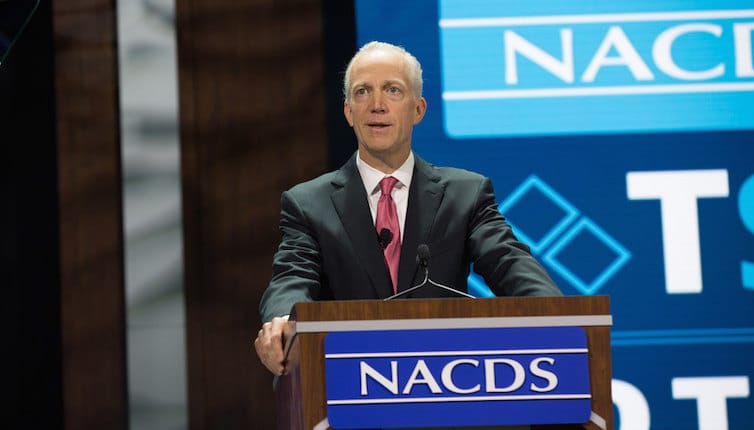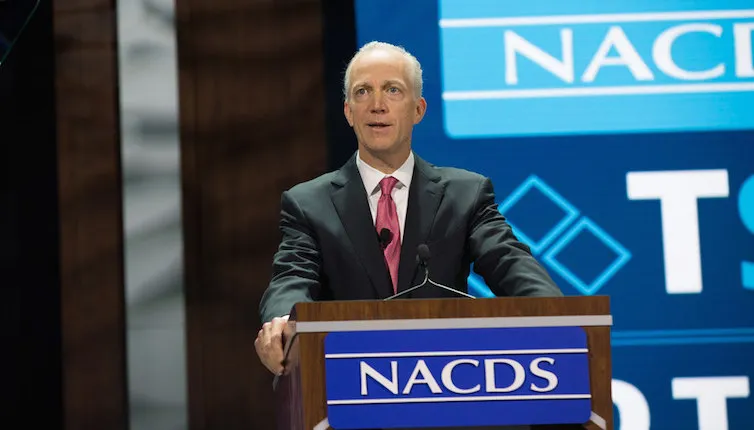
Martin Otto, NACDS chairman and H-E-B chief merchant and CFO, addresses Total Store Expo attendees.
BOSTON — Pharmacy-based health care can help the U.S. meet an array of socioeconomic challenges, Martin Otto, chief merchant and chief financial officer of H-E-B, said at the National Association of Chain Drug Stores Total Store Expo.
Otto, who is also chairman of NACDS, said that access to pharmacy patient care can help reverse increases in poverty and declines in education. “It’s important that we as an industry help to take the lead in what health care and the related pieces look like,” he said. “We should work very, very hard to provide access to quality, affordable health care to all Americans.”
Spending on health care is crowding out spending for education and social services, which increases poverty and creates a vicious cycle, he observed. Because there is not enough money to adequately fund these priorities, Americans need to find ways to spend more wisely, he said. “Collectively we can lead the way — and we at NACDS can play a big part in that.”
Besides actively participating in public policy making and advocating on behalf of pharmacy, the association’s mission includes creating a marketplace for suppliers and retailers to get together, he noted. The expo, which drew some 5,500 participants and 735 exhibitors, “makes a real positive difference in terms of our businesses’ ability to serve our customers,” said Otto. “What we are accomplishing together can ultimately make a tremendous difference on issues that are posing significant challenges to our country.”
The event’s Meet the Market served as a venue for more than 7,000 meetings, jump-starting business transactions that flourished throughout the conference. Held before the opening of the show floor at the Boston Convention & Exhibition Center, the annual program introduced retailers to the latest products, technology and services. Exhibitors presented their company and products to retailers through a series of 10-minute appointments arranged by NACDS.
Once the show floor opened, a main attraction was the future-looking Vision 2027. The exhibit from multiple companies provided insights into what lies ahead for retailing and trading partner collaboration, with a blend of technology, interactivity and even celebrity. Vision 2027 was “a tremendous part” of “forward thinking at this year’s event,” said NACDS president and chief executive officer Steve Anderson.
Addressing attendees, Anderson spoke about the association’s effectiveness in putting the “public” back into public policy. Noting the declining state of political efficacy in the nation — which refers to the people’s belief that they can affect, and have a say in, the direction of government — he contrasted that with NACDS’ member-focused and patient-centered approach to everything it does. He cited programs that reflect the organization’s “authenticity of mission and effectiveness in action” in addressing such challenges as prescription drug abuse and access, improving patient care, fostering retailer-supplier partnerships that benefit consumers, and increasing engagement in the political arena.
He also described NACDS Foundation initiatives that focus on advancing public health, including education related to the Zika virus and increased screening for HIV and hepatitis C. “We put resources — not just public service ads — but we allocated money in the first quarter of this year and it’s continuing in terms of raising awareness” of Zika and its prevention, “which I think is absolutely critical,” he said. “We’ve been partnering with the Centers for Disease Control and Prevention. We’ve been partnering with the March of Dimes. And we are doing a digital campaign as well, which is terrific.”
Anderson said there are countless examples of how NACDS has put the public back into public policy, with perhaps the most significant being recent advocacy efforts supporting legislation addressing the opioid addiction crisis. He referenced two recent bipartisan and NACDS-backed pieces of legislation signed into law by the president this year: the Ensuring Patient Access and Drug Enforcement Act and the Comprehensive Addiction and Recovery Act. By actively addressing the issue of opioid addiction, NACDS put patients first, ensuring zero tolerance for drug abuse while also assuring patients have access to medications they legitimately need.
“Ten years ago we weren’t winning a lot of public policy victories,” he commented. “Members of Congress viewed our members as retailers that sold drugs in addition to many different products that are found in our stores, but they never really viewed us as part of the health care delivery system. So the board of directors said that we were going to revitalize NACDS and move in a different direction.”
Business sessions at the expo included the program titled “I Got on the Shelf, Now What?” featuring Mark Young, founder and CEO of Jekyll & Hyde Advertising. Other topics ranged from branding to the supply chain to pharmaceutical trends.
Daymond John of “Shark Tank” spoke with Meet the Market participants, advising them on how to refine the all-important elevator pitch. First-time exhibitors benefited from the insights of three panels of NACDS Retail Advisory Board members, who shared their hard-earned insights from decades of industry success.
The popular Product Showcase gave retailers looking for new merchandising ideas the opportunity to preview products in advance of the floor’s opening, and again in showcases on the floor, giving them invaluable exposure. Product Showcase winners included items in categories from baby care to home health care.
NACDS also created an Online Press Room for exhibitors to announce new products and other news related to their company’s participation.







